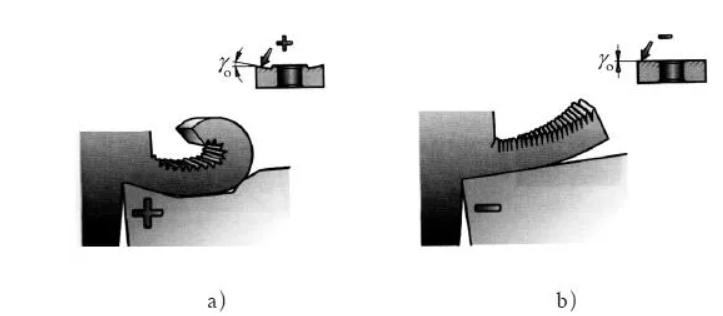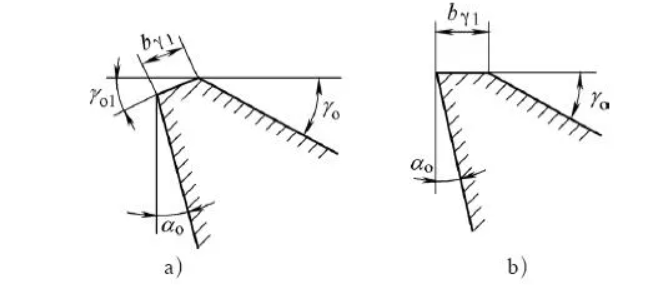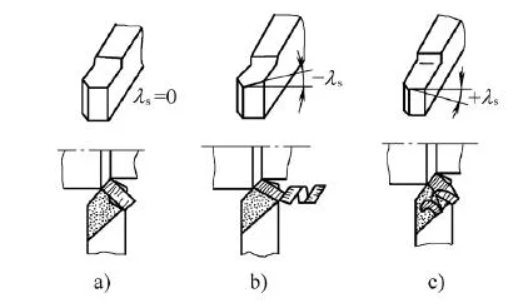(a) the function of the front angle and selection
1. the function of the front angle The front angle is one of the important geometric angle of the tool, its value size, positive and negative on the cutting deformation, cutting force, cutting temperature, tool wear and has a great impact on the quality of the machined surface.
(1) Influence cutting deformation. Increase the front angle, the cutting deformation can be reduced, cutting force, cutting heat and cutting power to reduce.
(2) affect the cutting edge strength and heat dissipation. Increase the front angle, will make the wedge angle reduced, the cutting edge strength decreased, heat dissipation volume reduced; too large front angle, may lead to bending stress at the cutting edge, resulting in chipping.
(3) affect the chip form and chip breaking effect. Different degrees of cutting deformation, chip breakage is different degrees of difficulty (see Figure 1-49).
(4) Affects the quality of the machined surface.

2. Selection principles The reasonable front angle of the tool depends mainly on the properties of the tool material and the workpiece material, namely.
(1) When the bending strength and impact toughness of the tool material is high, a large front angle can be selected.
(2) the workpiece material strength and hardness is larger, it is appropriate to choose a smaller front angle to ensure that the tool edge strength; conversely, it is appropriate to choose a larger front angle.
(3) Other specific processing conditions.
3. the front angle selection recipe
The role of the front angle is large, choose it reasonably; the workpiece hardness is high, the front angle to choose small; workpiece plasticity, the front angle to choose large; carbide tool, the front angle to choose small.
High-speed steel tools, choose a large front angle.
Rough machining front angle is small, finishing front angle is large.
4. the use of negative chamfering to strengthen the cutting edge The front angle of the tool increases, although the cutting deformation and cutting force can be reduced, but often limited by the strength of the cutting edge. Grinding chamfers on the front face of a positive front angle is a better solution. The chamfering surface can be negative, zero or small, with negative chamfers being used more often in practice.

The main purpose of chamfering is to strengthen the edge and reduce tool breakage. When roughing or intermittently cutting brittle and hard materials, negative chamfers reduce chipping and increase tool life. When milling hardened steel with ceramic tools, an edge without a chamfer cannot be machined. In addition, the larger wedge angle at the tool chamfer can improve the heat dissipation conditions.
(B) The function and selection of the back angle
The main function of the back angle is to reduce the friction between the back tool surface and the machining surface, which affects the quality of the machined surface and the tool life.
(1) Increase the back angle to reduce the length of contact between the elastic recovery layer of the machined surface and the back tool face, reducing the friction and wear of the back tool face.
(2) Increase the rear angle, so that the wedge angle is reduced, the radius of the blunt edge rn is reduced, and the edge is sharp.
(3) When the rear tool face is dulled by the same standard VB, when resharpening, the tool with a large rear angle grinds away a large volume of metal.
2. Selection principles
(1) the workpiece material plasticity and toughness, should take a larger rear angle. For example, processing titanium alloy should take a larger back angle.
(2) finishing when the cutting thickness is small, it is appropriate to choose a larger back angle.
(3) for fixed-size tools (such as round hole broaches, reamers), it is appropriate to choose a smaller back angle, which can extend the tool life.
(4) process system stiffness is poor, easy to produce vibration, should choose a smaller back angle.
(C) the main (vice) offset angle of the function and selection
1. The function of the main deviation angle
(1) Affect the quality of the machined surface. Increase the main angle of deviation and sub angle of deviation, so that the roughness of the machined surface value increases.
(2) Affects the size of the cutting layer and the strength of the tool tip and chip breaking effect.
(3) Affect the ratio of each cutting component force.
2. The principle of choosing the main deviation angle
(1) When the process system stiffness is good, should choose a small main deflection angle to improve the tool life and has been processed surface quality.
(2) When processing very hard workpiece materials (such as chilled cast iron, hardened steel), it is appropriate to take a smaller main deflection angle to reduce the load on the cutting edge per unit length, improve the tool tip heat dissipation conditions and improve tool life.
(3) The workpiece shape and specific conditions should also be considered.
3. The principle of choosing the sub-deflection angle
(1) Under the condition of good rigidity of the process system and no vibration, a smaller sub-deflection angle should be taken to reduce the machined surface roughness value.
(2) When finishing, the sub-deflection angle should be smaller than that of rough machining.
(3) processing strength, hardness of the workpiece material or intermittent cutting, in order to improve the strength of the tool tip, it is appropriate to take a smaller value of the sub-deviation angle (4 ° ~ 6 °).
(4) cut off (slot) knife, saw milling cutter, drill, reamer, etc. due to the structural strength or processing size accuracy restrictions, can only take a very small sub-deviation angle (1 ° ~ 2 °).
(D) the function and selection of the edge inclination angle
1. the function of the edge inclination angle
(1) Influence the direction of chip flow. When λs is negative, the chip flow to the machined surface, easy to scratch the machined surface; λs is positive, the chip flow to the surface to be machined, as shown in Figure 1-51. Therefore, finishing is often done with a positive edge inclination.

(2) Affects the tip strength and the impact position of the cutting edge during interrupted cutting.
(3) Affects the sharpness of the cutting edge.
(4) Affects the ratio of cutting forces.
(5) Affects the actual working length of the cutting edge. 2.
2. Selection of the cutting edge inclination angle
(1) mainly according to the nature of processing to choose. When fine turning, λs=0°~5° is often taken; when rough turning, λs=0°~-5° is taken to improve the cutting edge strength of the tool; when there is impact load, in order to protect the tool tip, λs=-5°~-15° is often taken.
(2) According to the process system stiffness selection. When the process system stiffness is not enough, should not choose negative edge inclination.
(3) According to the tool material to choose. The brittle tool material, in order to ensure the cutting edge strength, should not choose the positive edge inclination angle.
(4) according to the workpiece material to choose. When processing high hardness workpiece material, it is appropriate to take the negative edge inclination.
Contact: Jacky Wang
Phone: +86 14714816052
Tel: +86 14714816052
Email: jacky@cncnctools.com
Add: Floor 1, Shixi Industrial area, Canton, Guangdong, China. 510288